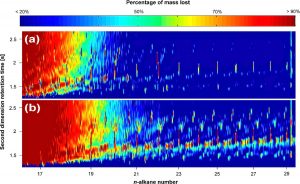Study Uncovers Spectrum of Fate for Weathered Oil
– August 19, 2014
U.S. and Swiss chemists used comprehensive two-dimensional gas chromatography (GCxGC) to more accurately understand oil fate from the Deepwater Horizon spill.
They separated, identified, and quantified distinct hydrocarbons in weathered oil, shedding new light on persistent and mostly-overlooked compounds. They developed a catalog that provides measurable indicators to classify and order the microbial degradation of petroleum hydrocarbons. The team published their findings in the January 2014 issue of Environmental Science & Technology: Resolving biodegradation patterns of persistent saturated hydrocarbons in weathered oil samples from the Deepwater Horizon disaster.
Nature degrades surface and subsurface oil, but that process depends heavily on environmental factors and oil composition. Many different and mostly saturated hydrocarbons, also known as unresolved complex mixtures (UCMs), are typically the dominant component in weathered oil but are difficult to analyze with conventional gas chromatography. As such, there is limited information about their biodegradation. This study’s goal was to learn more about oil compounds using GCxGC to separate and identify UCMs and quantify the rate, extent, and potential cessation of their biodegradation in wet and dry sand environments.
Researchers studied eight weathered oil samples collected during April to November 2011 from Gulf of Mexico beaches. The most volatile and soluble compounds were either partly or totally absent from these samples, providing an excellent example where traditional gas chromatography could not identify compositional differences among the remaining compounds.
Their analyses showed that about half of the original oil load in the most weathered oil sample had been removed by mass transfer and mineralization processes. The remaining oil was a mixture of persistent and partly-degraded compounds, consisting of aromatics (4%), saturated hydrocarbons (14%), and oxygenated compounds (31%). Extrapolating from these numbers, researchers estimated that the saturated compound group represented about 8-10% or 38-68 thousand metric tons of the oil originally released from the Macondo well. However, because the oxygenated compounds (31%) were invisible to conventional gas chromatography-based techniques, the team cautioned against equating the disappearance of compounds from the GCxGC chromatograms with removal.
Results showed that biodegradation was not a simple stepwise process, as different saturate classes (alkanes in Carbon range C22 – C29) were consumed simultaneously but at different rates and extents. The team developed a new biodegradation index that incorporated the time-dependent compositional evolution of saturates greater than C22. The time that samples remained in the surface environment and the local conditions favoring biodegradation likely accounted for the observed variability among samples.
In their discussions, the researchers found significant gains from using comprehensive two-dimensional gas chromatography, as it clarified differences in UCMs that would have looked similar in conventional gas chromatography analysis. The ability to quantitatively differentiate biodegradation in wet and dry beach environments provides information that may be useful in toxicity assessments. And, the new index could improve estimates of overall mass balances of weathered oil from the spill.
The study’s authors are Jonas Gros, Christopher M. Reddy, Christoph Aeppli, Robert K. Nelson, Catherine A. Carmichael, and J. Samuel Arey.
A group of these authors were involved with another study that narrowed the pool of compounds – including saturates – as precursors of oxidized compounds. After conducting analyses of 41 two-dimensional gas chromatography chromatograms, the largest study of Deepwater Horizon oil samples to date, they published their results in the October 2013 issue of Marine Pollution Bulletin: Oxygenated weathering products of Deepwater Horizon oil come from surprising precursors.
************
This research was made possible in part by grants from BP/The Gulf of Mexico Research Initiative (GoMRI) to the Deep Sea to Coast Connectivity in the Eastern Gulf of Mexico Consortium (Deep-C). Other funding sources included the National Science Foundation (OCE-0960841, EAR-0950600,and RAPID OCE-1042097). C.A. acknowledges a Swiss National Science Foundation Postdoctoral Fellowship.
The GoMRI is a 10-year independent research program established to study the effect, and the potential associated impact, of hydrocarbon releases on the environment and public health, as well as to develop improved spill mitigation, oil detection, characterization and remediation technologies. An independent and academic 20-member Research Board makes the funding and research direction decisions to ensure the intellectual quality, effectiveness and academic independence of the GoMRI research. All research data, findings and publications will be made publicly available. The program was established through a $500 million financial commitment from BP. For more information, visit https://gulfresearchinitiative.org/.
© Copyright 2010- 2017 Gulf of Mexico Research Initiative (GoMRI) – All Rights Reserved. Redistribution is encouraged with acknowledgement to the Gulf of Mexico Research Initiative (GoMRI). Please credit images and/or videos as done in each article. Questions? Contact web-content editor Nilde “Maggie” Dannreuther, Northern Gulf Institute, Mississippi State University (maggied@ngi.msstate.edu).






